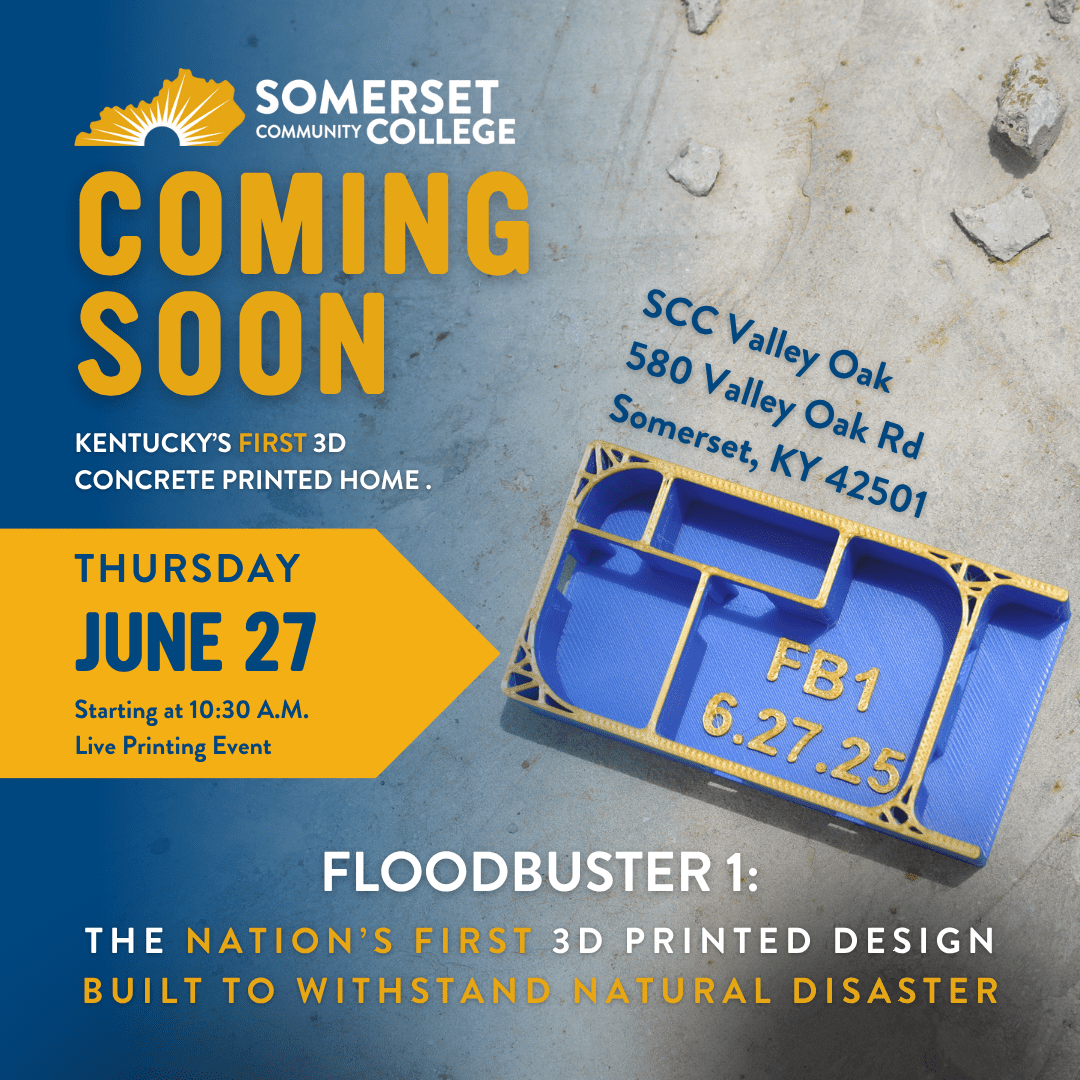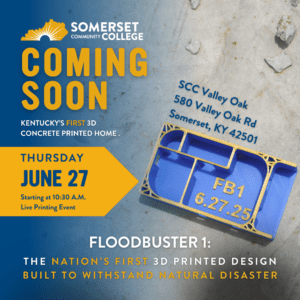Community invited to see the process first-hand on June 27th
Somerset, KY- Somerset Community College (SCC) is at the helm of Floodbuster 1—Kentucky’s first-ever 3D Concrete Printed (3DCP) structure. The project builds on SCC’s decade of experience in additive manufacturing, turning years of research and training into a real-world demonstration of what’s next in homebuilding. The project brings together educational, nonprofit, and industry collaborators committed to advancing what’s possible in modern homebuilding. SCC is working to show how innovative design and new construction methods can meet the growing demand for resilience, speed, and design adaptability in housing.
On June 27, 2025, SCC will host a public event where community members and guests are invited to witness the first layers of Kentucky’s inaugural 3D Concrete Printed (3DCP) structure take shape in real time.

Building on a Decade of Additive Manufacturing Leadership
Floodbuster 1 signifies a new chapter in SCC’s longstanding commitment to additive manufacturing. Over the past decade, SCC has become a national leader in 3D printing education and application, thanks in large part to the vision and expertise of Professor Eric Wooldridge, PE, RA, MsEng, who developed SCC’s additive manufacturing program and serves as Director of KCTCS’s Additive Manufacturing Center. Under his leadership, SCC launched the nation’s first statewide additive manufacturing certificate program, training more than 5,000 college students, 250+ K–12 teachers, and 105 dual-credit instructors, while introducing over 10,000 K–12 students to the principles of 3D printing.
This deep well of experience has not only democratized access to emerging technologies across Kentucky but has also laid the groundwork for what’s happening now: the application of that expertise to build something tangible,timely, and transformational.
“It is important to realize we are not talking about the distant or even the near future,” said Wooldridge.“We already have the [3D printing] technology right here and now to build a cost-effective structure, that compared to wood, might as well be virtually indestructible.”
The urgency of this work is clear. America’s housing market is straining under the combined pressures of material inflation, workforce shortages, and increasingly severe weather events. Modern wood-framed homes, once the standard of affordable construction, now have a typical lifespan of just 50 to 60 years, often requiring major repairs within a single generation. Natural disasters, including floods, tornadoes,
and wildfires, are pushing communities further into instability, while the cost of rebuilding frequently exceeds the value of what was lost.
With structural features designed to resist high-impact stress and a construction process that dramatically reduces build time, Floodbuster 1 serves as a working model of how construction might evolve to meet the challenges of the present—and prepare for what’s next.
“The Floodbuster1 is a concrete example—literally—of Professor Wooldridge and SCC’s leadership in next-generation construction technology,” said Jennifer Seifert, Principal of PROGRESS Appalachia. “We’re excited to support the SCC team as they continue turning their bold vision into practical solutions for families in Appalachia.”
Collaborative Efforts for Innovation
Floodbuster 1 is the product of collaboration between education, industry, and mission-driven partners, each contributing unique resources and expertise to bring this concept to life. Habitat for Humanity Pulaski County contributed reference plans during the design phase and will furnish the completed home with appliances to help simulate a real-world living environment. Students in SCC’s Heavy Equipment Operations (HEO) program assisted in digging the foundation and footer of the home, supported by
longtime program partners Brandeis Machinery, Boyd CAT, and Martin Contracting, Inc., who also donate and haul equipment for the HEO program. Additional support came from OBH Renovations, which provided technical expertise and assistance, and IMI Concrete, which supplied cost-effective foundation materials that supported the project’s efficient execution. Providing the advanced robotics behind the build, RIC Robotics is delivering the 3D concrete printing technology for Floodbuster 1, deploying its proprietary system to complete the structural print. PROGRESS Appalachia is providing strategic support and outreach, helping to connect the project to broader conversations about regional revitalization and housing resilience. With a focus on turning local innovation into long-term opportunity for Appalachian communities, PROGRESS is committed to expanding the Floodbuster concept through a
continued series of builds, working toward scalable solutions for Kentucky and the greater Appalachian region.
Community Event: June 27th
To mark the construction milestone, guests are invited to join SCC on campus on June 27 th , 2025, to see the printing in action, meet project partners, and learn more about what this model could mean for future housing development in the region.
To RSVP and get event updates, visit Floodbuster 1: Kentucky’s First 3D Printed Structure
Media Attendance
A media Q&A will take place immediately following the speaker’s remarks during the June 27 event. Members of the press are encouraged to RSVP at: https://somersetcc.info/FloodbusterMediaRSVP
About Somerset Community College
Somerset Community College (SCC), a member of the Kentucky Community and Technical College System (KCTCS), provides high-quality, affordable, and accessible education and training to fosters tudent success, economic growth, and an enhanced quality of life. Serving the south-central region of Kentucky, SCC offers a diverse range of programs, including associate degrees, diplomas, and certificates across various fields. With multiple campuses and centers, the college is committed to meeting the
educational and workforce needs of its communities, preparing students for both immediate employment and successful transfer to four-year institutions.
About Habitat for Humanity Pulaski County, Kentucky
Habitat for Humanity of Pulaski County, KY, has been building and repairing homes locally since 2011.Guided by the belief that everyone deserves a safe and decent place to live, the organization brings people together to build homes, communities, and hope. Habitat offers a hand up, not a handout — partner families contribute sweat equity and pay an affordable mortgage, while the organization supports low-
income homeowners in improving and maintaining their homes. Through shelter, we empower.
About PROGRESS Appalachia
PROGRESS Appalachia is rooted in the belief that healthy families, reliable jobs, and self-sufficient communities form the foundation of a prosperous America. Its mission is to rebuild Appalachian communities with practical, results-driven investments in housing, agriculture, and workforce infrastructure. Guided by three pillars—Appalachia Grows, Appalachia Builds, and Appalachia Thrives—PROGRESS works to turn local strengths into long-term opportunity.
About RIC Robotics
RIC Robotics is a robotic construction company specializing in the integration of advanced robotics, artificial intelligence, high-performance materials, and parametric design into the building process. The company’s mission is to revolutionize the construction-design industry. In addition to structural performance, RIC Robotics places emphasis on architectural design, with tools that support the creation of buildings that are both functional and visually distinctive. Their capabilities extend beyond 3D printing to offer end-to-end solutions for large-scale construction projects.


